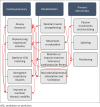Airway clearance therapy in acute paediatric respiratory illness: A state-of-the-art review
- PMID: 31309166
- PMCID: PMC6620562
- DOI: 10.4102/sajp.v75i1.1295
Airway clearance therapy in acute paediatric respiratory illness: A state-of-the-art review
Abstract
Background: Despite unclear evidence of effectiveness or safety, airway clearance therapy (ACT) is frequently performed in infants and children with acute pulmonary disease.
Objectives: The aim of this review was to critically synthesise published evidence, expert opinion and pathophysiological principles to describe the indications, effects, precautions and application of commonly used ACT modalities for managing infants and children with acute pulmonary disease.
Method: A comprehensive narrative review of published literature was conducted. Articles describing paediatric populations were prioritised, but adult and animal studies were also considered where appropriate.
Results: There is a dearth of high-level evidence supporting the use of ACT in acutely ill infants and children. Conversely, studies have highlighted the lack of effect of different modalities for a variety of conditions, and in some cases serious associated complications have been reported.Airway clearance therapy may be considered when there is retention of pulmonary secretions, and the consequential airway obstruction impacts either acutely on respiratory mechanics and gaseous exchange and/or has the potential for long-term adverse sequelae [a condition that is the consequence of a previous disease or injury]. However, it should not be considered a routine intervention.
Conclusion: Airway clearance therapy should not be performed routinely in children admitted to hospital with acute respiratory conditions. Patients should be clinically assessed and treatment planned according to individual presentation, in those with signs and symptoms that are potentially amenable to ACT.
Clinical implications: This review can serve as a guide for physiotherapists in the respiratory management of children with acute respiratory illness, as well as identifying areas for clinical research.
Keywords: acute; airway clearance therapy; chest physiotherapy; lower respiratory tract infection; paediatric; physical therapy.
Conflict of interest statement
The author declares that she has no financial or personal relationships that may have inappropriately influenced her in writing this article.
Figures





Similar articles
-
Use of airway clearance therapy in children hospitalised with acute lower respiratory tract infections in a South African paediatric hospital.S Afr J Physiother. 2020 Feb 19;76(1):1367. doi: 10.4102/sajp.v76i1.1367. eCollection 2020. S Afr J Physiother. 2020. PMID: 32161827 Free PMC article.
-
Airway clearance devices for cystic fibrosis: an evidence-based analysis.Ont Health Technol Assess Ser. 2009;9(26):1-50. Epub 2009 Nov 1. Ont Health Technol Assess Ser. 2009. PMID: 23074531 Free PMC article.
-
Airway clearance techniques and use of mucoactive agents for adult critically ill patients with acute respiratory failure: a qualitative study exploring UK physiotherapy practice.Physiotherapy. 2020 Sep;108:78-87. doi: 10.1016/j.physio.2020.06.003. Epub 2020 Jul 1. Physiotherapy. 2020. PMID: 32721607
-
Chest Physiotherapy in the Pediatric Intensive Care Unit.J Pediatr Intensive Care. 2015 Dec;4(4):174-181. doi: 10.1055/s-0035-1563385. Epub 2015 Aug 12. J Pediatr Intensive Care. 2015. PMID: 31110870 Free PMC article. Review.
-
Oscillating devices for airway clearance in people with cystic fibrosis.Cochrane Database Syst Rev. 2020 Apr 30;4(4):CD006842. doi: 10.1002/14651858.CD006842.pub5. Cochrane Database Syst Rev. 2020. PMID: 32352564 Free PMC article.
Cited by
-
Immediate effects of manual hyperinflation on cardiorespiratory function and sputum clearance in mechanically ventilated pediatric patients: A randomized crossover trial.Hong Kong Physiother J. 2022 Jun;42(1):15-22. doi: 10.1142/S1013702522500020. Epub 2021 Sep 29. Hong Kong Physiother J. 2022. PMID: 35782699 Free PMC article.
-
Current and Emerging Therapies to Combat Cystic Fibrosis Lung Infections.Microorganisms. 2021 Sep 3;9(9):1874. doi: 10.3390/microorganisms9091874. Microorganisms. 2021. PMID: 34576767 Free PMC article. Review.
-
Refractory Atelectasis and Response to Chest Physiotherapy.J Pediatr Intensive Care. 2021 Jun 21;12(2):156-157. doi: 10.1055/s-0041-1728640. eCollection 2023 Jun. J Pediatr Intensive Care. 2021. PMID: 37082467 Free PMC article. No abstract available.
-
Use of airway clearance therapy in children hospitalised with acute lower respiratory tract infections in a South African paediatric hospital.S Afr J Physiother. 2020 Feb 19;76(1):1367. doi: 10.4102/sajp.v76i1.1367. eCollection 2020. S Afr J Physiother. 2020. PMID: 32161827 Free PMC article.
-
Inspiratory muscle training in children and adolescents living with neuromuscular diseases: A pre-experimental study.S Afr J Physiother. 2021 Aug 31;77(1):1577. doi: 10.4102/sajp.v77i1.1577. eCollection 2021. S Afr J Physiother. 2021. PMID: 34522820 Free PMC article.
References
-
- Agostini P. & Knowles N., 2007, ‘Autogenic drainage: The technique, physiological basis and evidence’, Physiotherapy 93(2), 157–163. 10.1016/j.physio.2006.07.005 - DOI
-
- American Association for Respiratory Care (AARC) , 1993, ‘AARC clinical practice guideline. Use of positive airway pressure adjuncts to bronchial hygiene therapy’, Respiratory Care 38(5), 516–521. - PubMed
-
- Argent A.C., Ahrens J., Morrow B.M., Reynolds L.G., Hatherill M., Salie S. et al. , 2014, ‘Pediatric intensive care in South Africa: An account of making optimum use of limited resources at the Red Cross War Memorial Children’s Hospital’, Pediatric Critical Care Medicine 15(1), 7–14. 10.1097/PCC.0000000000000029 - DOI - PubMed
LinkOut - more resources
Full Text Sources
